Following on from Eating in Tokyo – Part 4 – Shinjuku and Ginza…
Did you know that the city of Tokyo alone holds more than 200 Michelin-starred restaurants? That’s one city with the largest number of Michelin-starred restaurants in the world! On my trip to Japan earlier this year, my sister allowed me to pick just ONE restaurant to try. How do you pick?! After doing some research and figuring out which restaurants allowed photos of food (a lot do not allow photos), I picked two Michelin-starred Narisawa’s degustation (¥23,760 inc tax and service fee; about AUD$287 at the time). The website did not state how many courses would be provided but I didn’t care. The food philosophy is based on the preservation of the natural environment satoyama and bringing the beautiful landscapes and the seasons to the plate. Its genre of cuisine is ‘innovative satoyama’.
Bookings from overseas can be made online but they only open on the 1st of the month prior to your reservation date. I had this date saved as an alarm on my phone, and booked straight away to ensure we secured a table. This was good planning as by mid-morning, the restaurant was booked out for the day we wanted – a Wednesday lunch service. The entrance wasn’t as grand as expected and looked more like a side door than a front door.
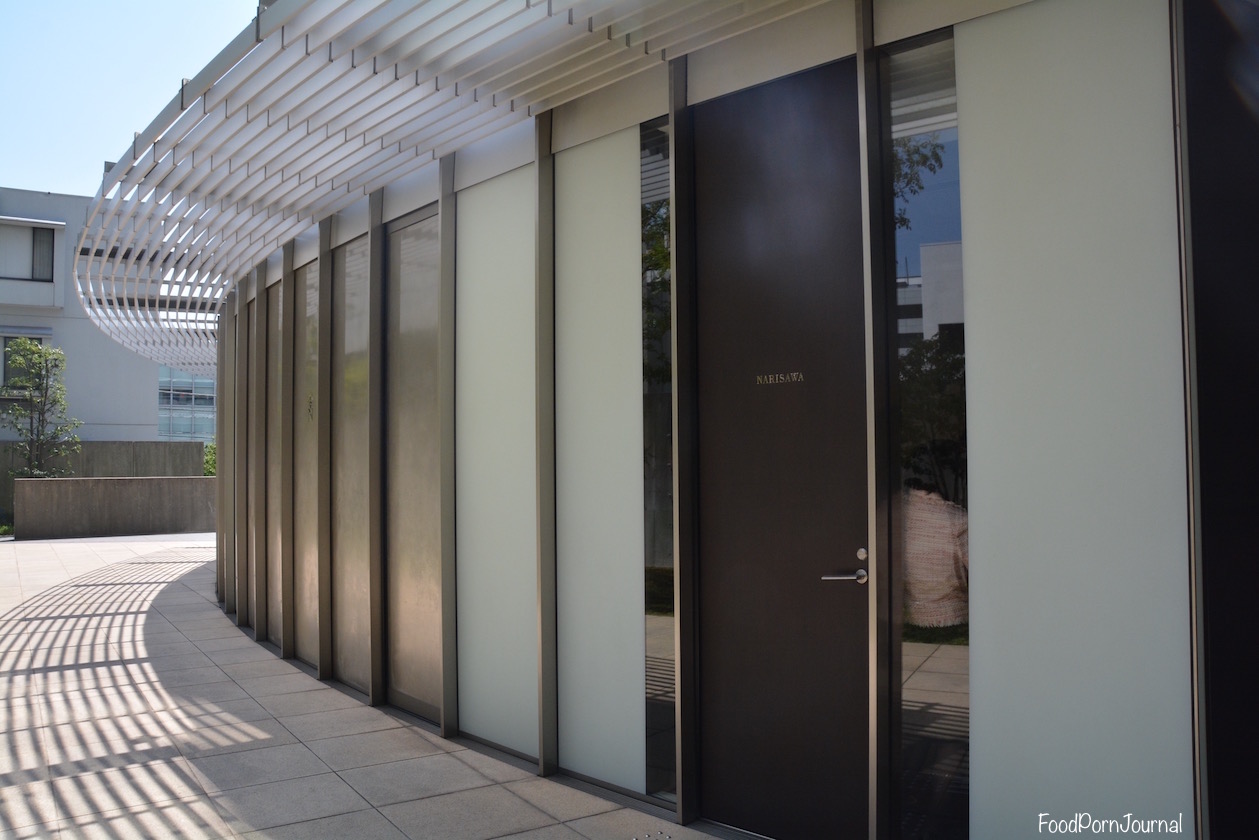
When we arrived, we were greeted warmly, our bags and coats were placed in a cloak room and we were shown to our table. The menu was explained to us and we found out there would be 14 courses! We were first asked about dietary requirements. We were then informed that there would be reptilian dishes in the degustation but it could be substituted for something else if we preferred. We were both curious to taste something reptilian and were happy with whatever would be put in front of us. The tables were set with a Narisawa glass plaque, the menu for the day and a warm towel for our hands.

As it was cherry blossom season, sakura cocktails were the specialty that day. Staff turned these into mocktails for us when we told them we didn’t drink alcohol (I don’t remember the price of this). The sakura was a little sour and a bit salty at the same time, yet mellowed out and sweet on the palate. Like nothing I’ve tasted before.
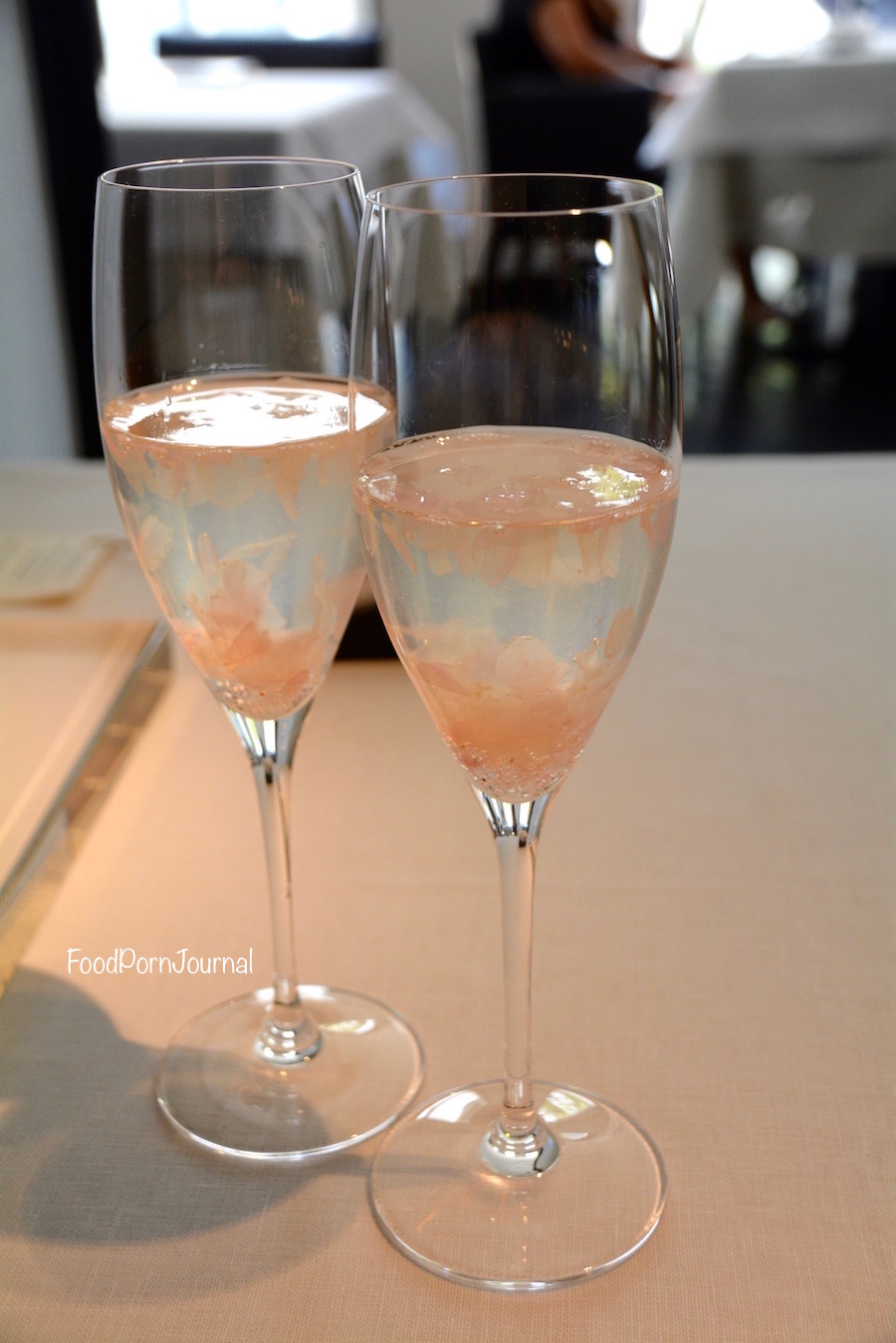
There was a matching tea option to each course which I decided to add on since YOLO. I have forgotten the cost of the tea matching but I think it was roughly an extra AUD$100. Our tea guy would place a glass of tea in front of me before the next course arrived and explained where the tea was harvested and what it should taste like. We noticed that some of the waiters were fluent in both Japanese and English which was great for us. The first tea to match our first course was a gyokuro iced tea from Kyoto that had been pickled for 21 days to provide some bitterness. It wasn’t too bitter for me as it was served icy cold.

Course 1 – Satoyama scenery and essence of the forest. Served on timber platter with the bark still intact on the outer edges, this really did look like something from a forest. We were encouraged to drink from a small ‘cup’ made from a hollowed out branch to set the scene. The water had been soaked in cedar and oak bark, yet tasted so fresh like it had just come out of a spring. The best water I’ve ever tasted! The rest of the ‘forest’ consisted of soil matcha, bamboo ‘bark’ (the stick that’s poking out), fried thinly sliced root vegetables, tofu and home made yoghurt. I loved this first course and it really set the scene for the courses to come, immediately introducing the freshness and purity of nature.

Course 2 – baby sweet fish and sakura. These fish were caught in a river in Japan and become a lot more abundant in spring. The fish had been lightly fried and were to be eaten wholly. They were crunchy and a little bitter which worked well with the sweet sakura gel. Not a fan of the dish but it was interesting to try.

Course 3 – soft shelled turtle. This was my first time eating turtle so I did not know what kind of texture to expect. It was extremely soft and tender, and tasted a little like veal. It had been thickly coated in batter and seasoned with salt and pepper, and tasted very much like a variation of salt and pepper squid.

We received a complimentary dish of sweet onion in leek. It looked like it had been cooked until it was charcoal but it was surprisingly not burnt at all. Soft yet crunchy.

Course 4 – a platter with a trio of goods of Omi beef from Shiga, spiny lobster from Shizuoka, and sea snake soup from Okinawa. The beef was tender and slightly charred on a ball of rice on top of a rice cracker. The lobster sashimi had a very delicate flavour and the caviar on top helped give it some punchiness. Accompanying the sea snake soup were locally grown vegetables. I can’t say that the soup tasted like snake as I have never eaten snake before. It was hot and tasted a little bit like chicken stock. The matching tea was a roasted green tea with notes of caramel.

When placing this platter in front of us, our waiter asked if we would like to see the sea snake that had been used in the soup. I of course said yes, and out came the dried snake (no head). He told us some interesting facts – people go to the island of Okinawa to capture these snakes by hand so it is quite a laborious process, and the snakes are also used to make sake.

Course 5 – Akashi sea bream from Hyogo with Botan shrimp from Ishikawa. The sea bream had been cured in kelp and we were told the purpose of this was to transfer the umami from the kelp to the fish. Very interesting. I find these techniques so fascinating. The dish was accompanied by coriander and chilli in a yuzu sauce to add more acidity. A wonderfully fresh dish that got my taste buds tingling for more. The matching tea was made up of 50% green tea and 50% roasted rice tea, allowing the tea to taste a little bit like a rice cracker.
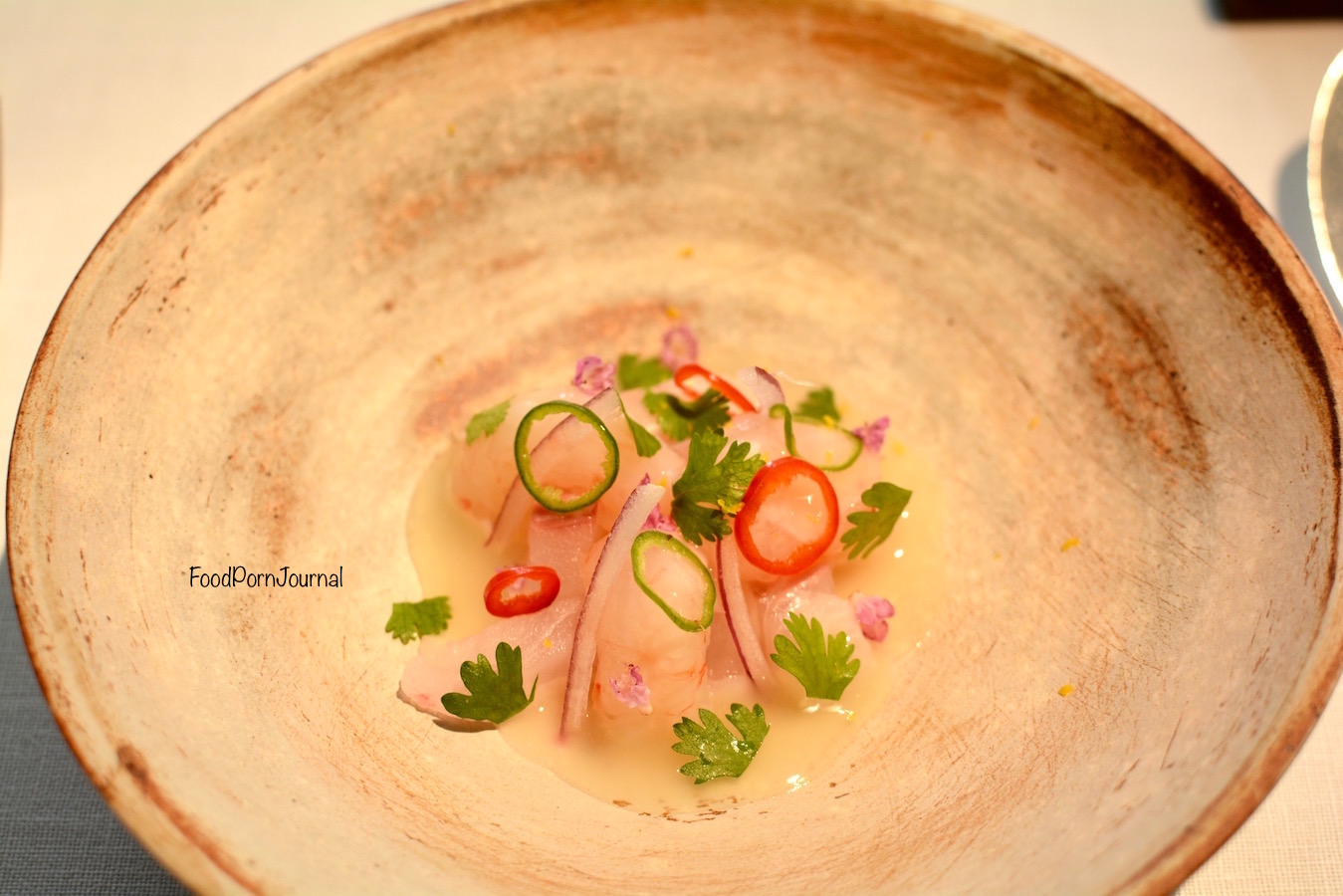
Course 6 – ‘Bread of the Forest’. A tray of live bread was placed on our table so that we could watch the last of the fermentation process. It sat in a small glass within a bowl of hot water and we did notice it rise very slowly. It was left on our table for the duration of the previous course, before a waiter came out to place it into a very hot stone bowl to cook.
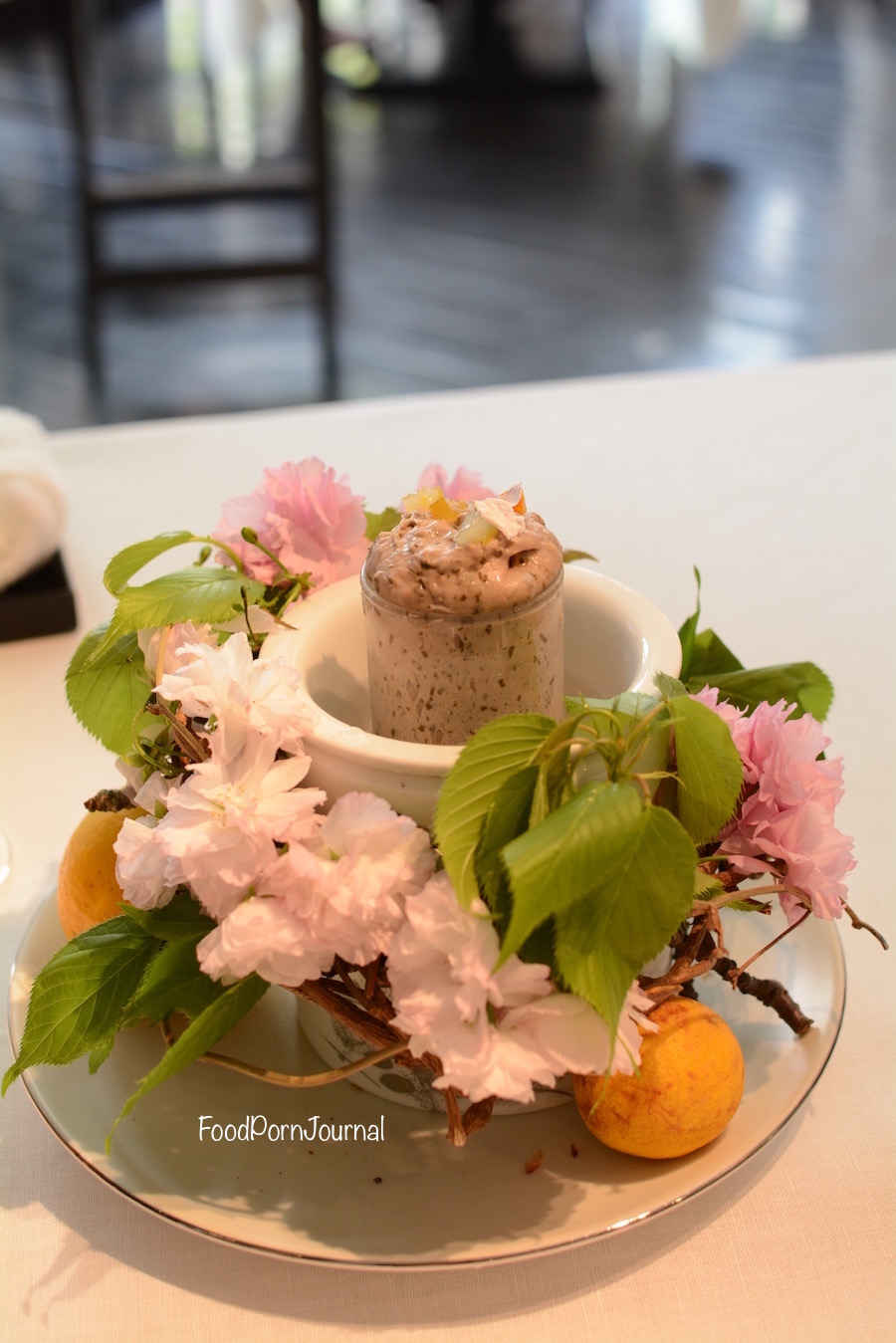
A thick wooden plank was left on top of the bowl for 12 minutes to allow the bread to bake.
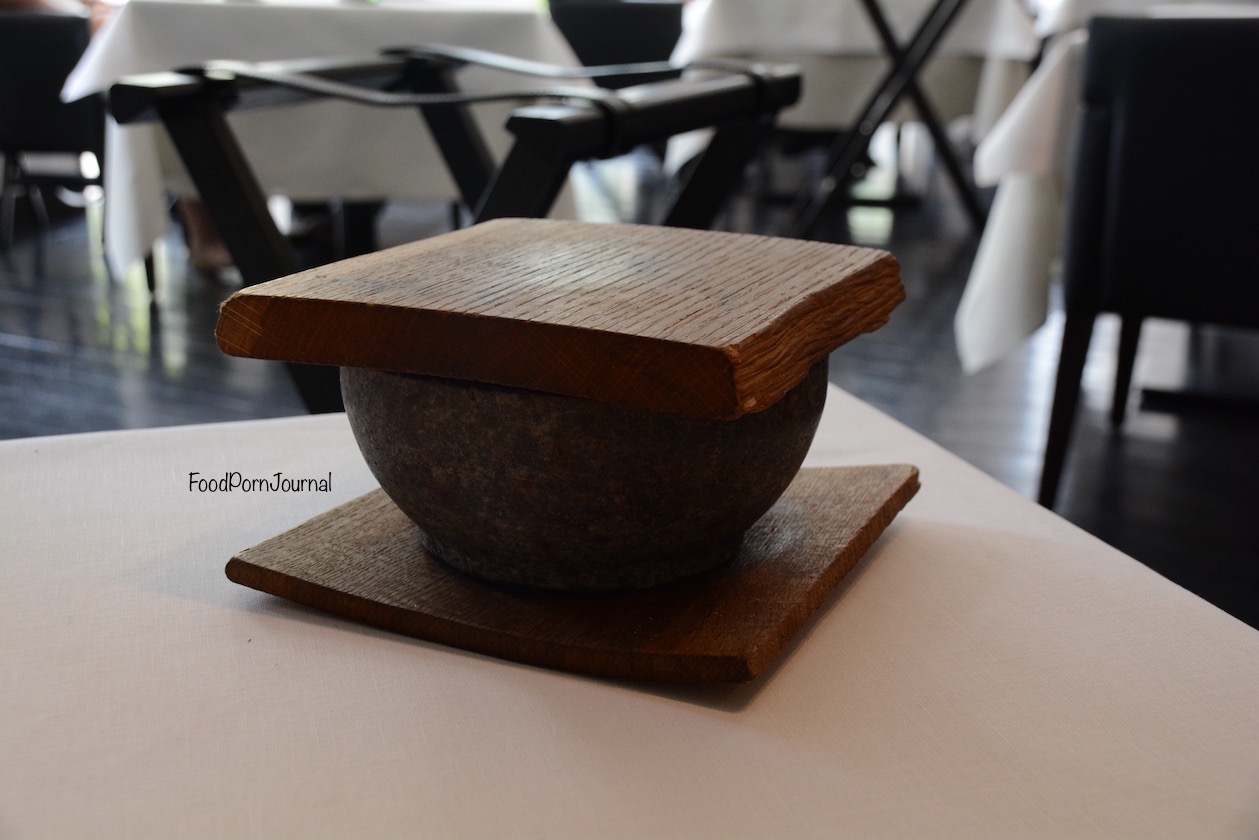
When opened, two perfectly plump baked bread rolls lay before us. The bread consisted of citrus fruits and sakura leaves.
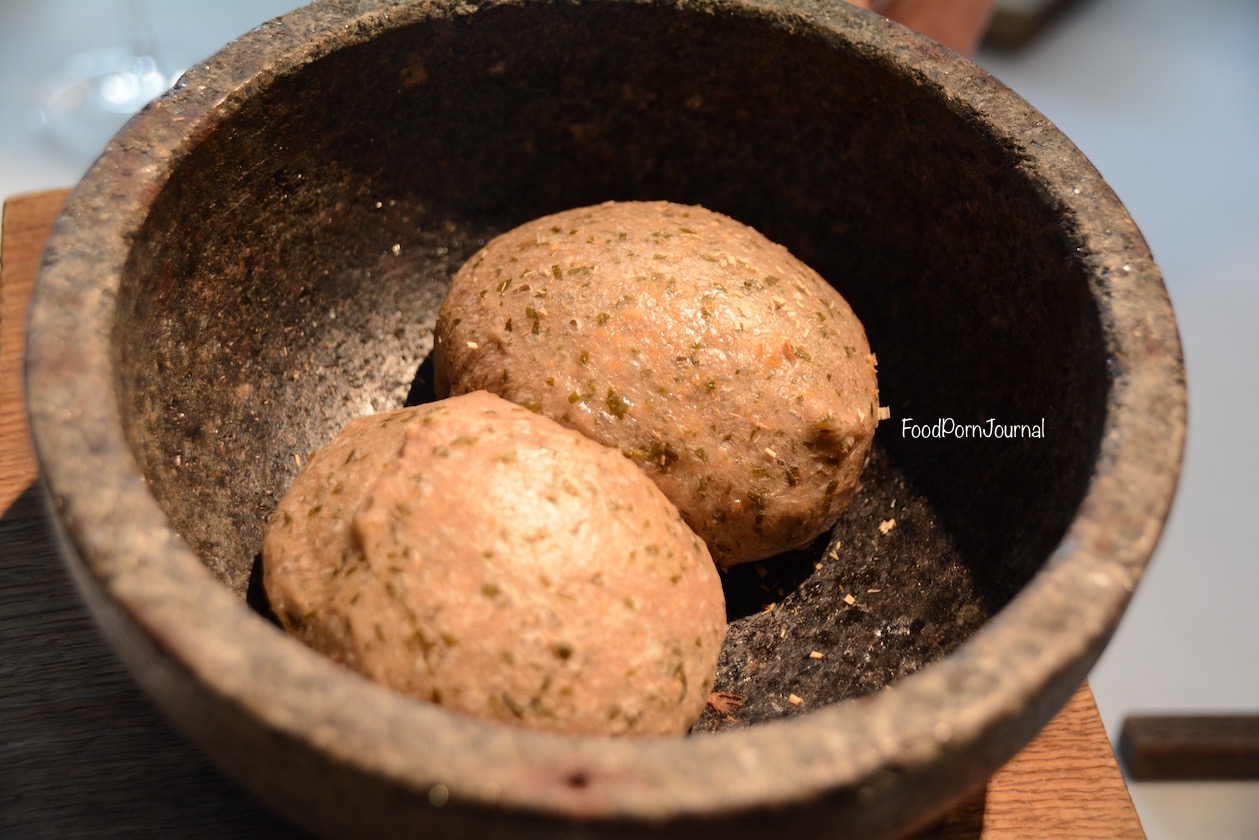
The team at Narisawa also make their own fermented butter. It is coated with black olive dust and spinach to make it look like a rock. Our waiter told us that so much time and effort goes into this and I can’t help but be impressed. The combination of the butter on the freshly baked bread was just amazing. The most delicious fruity bread I’ve had in my life. There wasn’t too much fruit but just enough to provide that little hit of sweetness. I closed my eyes and savoured every single bite to try and keep it locked in my memory. We were both so happy when more bread rolls were offered during the rest of the degustation! I know you’re not meant to fill up on bread but this was a must-eat!

Course 7 – clam from Mie with tomatoes and fava beans. Served on a bed of sea salt, the clam was warm and juicy in a delicious vegetable broth. The matching tea was a Shizuoka green tea that had been fermented in lactic acid which made the tea fizzy. This was enjoyable and just like a mocktail.

Course 8 – Langoustine shrimp from Shizuoka in a cappuccino infused butter foam with a butterbur bud and asparagus. This was perfectly cooked and tasted heavenly. The shrimp meat came out of its shell relatively easily with a few bits closer to the claws that were a bit trickier. This was one of the more simple but best tasting dishes.

The matching tea was a black tea that had matured so it was very mild. It was almost fruity with no bitterness.

Course 9 – tile fish from Yamaguchi that had been marinated for 1 day in koji (a mould typically used to ferment soy beans to make sake, soy sauce etc). This was beautifully presented in a glass sphere filled with fresh sakura inside, while the tile fish lay on top. The fish was soft and smooth, and I loved the crispy skin on top. It was served with a light sakura sauce and kinome, a Japanese green herb made into a sauce. The matching tea was a Shizuoka green tea which was a tad grassy but went perfectly well with the fish particularly in bringing out the herb sauce.
 A closer look at the dish.
A closer look at the dish.

Course 10 – black abalone from Kanagawa sauteed in butter eschalot sauce with bamboo shoots from Kyoto and the sancho flower which is available in the spring. My favourite part was the warm buttery sauce it was swimming in. I could have had several more servings of it!
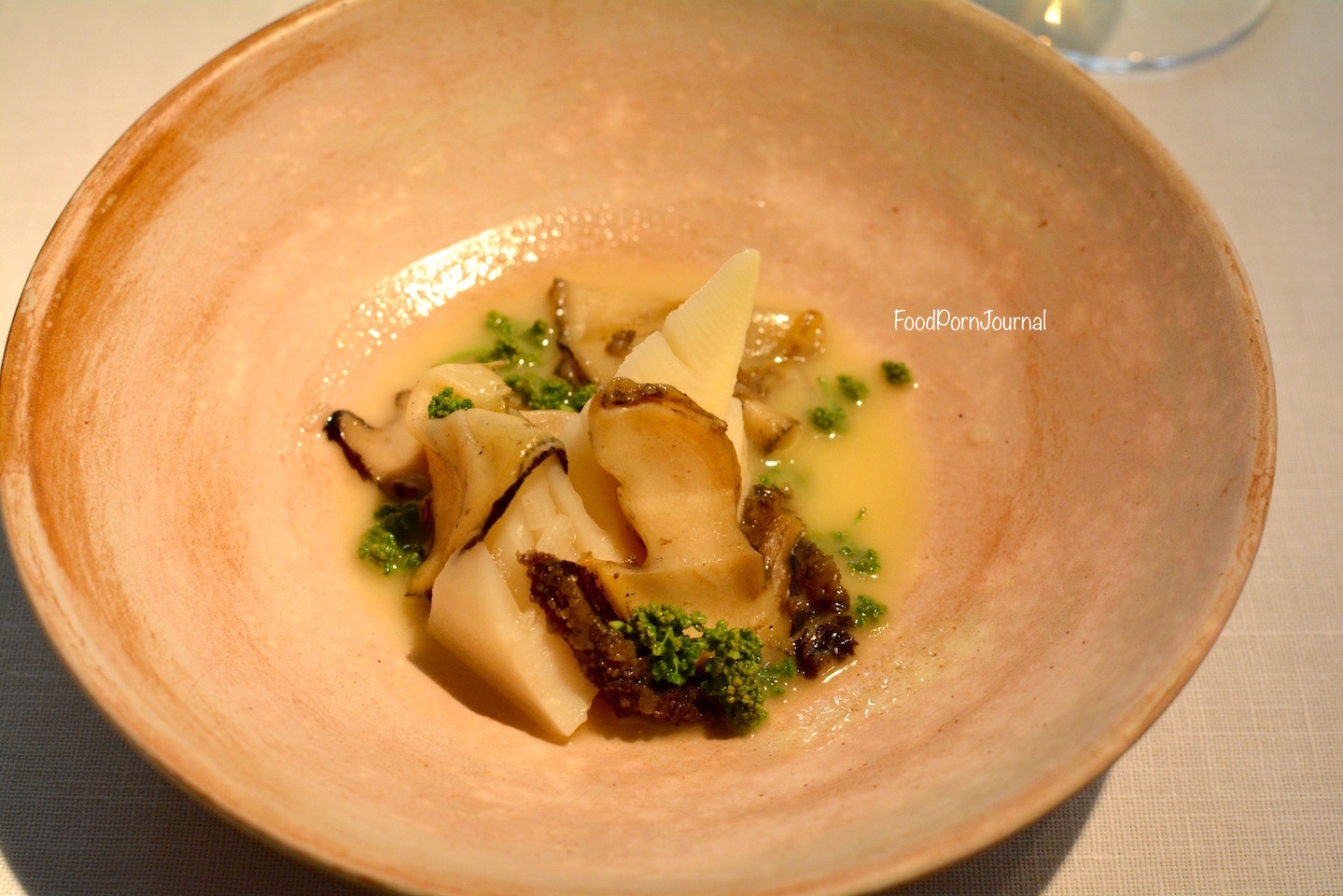
The matching tea was an oolong tea from Shizuoka. It was fresh and fruity, in between a green tea and an oolong tea.

Course 11 – blowfish (fugu) from Yamaguchi with deep fried shirako in a mint and citrus sauce. The blowfish was very tender as was the shirako (basically cod sperm). I had no idea what I was eating and thought it best to google it later, and I’m glad for that decision! In saying that, shirako tasted a little bit like squid less the chewy texture. The sauce had a subtle hint of citrus to lift the fishiness of the dish. The matching tea was a green tea made from gold leaves due a mutation to the leaves. Our waiter told us there were 10 times more amino acids in this mutation compared to a regular green tea.

Course 12 – duck from Kyoto. This was a Peking duck style in that the duck had been left over night to marinate and was constantly basted in rice oil, then cooked evenly. The muscles were left to contract in order to keep the juices and flavour in. The duck was accompanied by two sauces, a berry sauce and a Japanese green vegetable sauce with fermented garlic.

The matching tea was a black tea. Our waiter informed us that there weren’t many black teas in Japan but this was the best (and I can’t remember the name of it). It was very smooth with almost no bitterness.

Course 13 – our first dessert course of Tsubaki and Koji. The tusbaki is the camellia leaf that had been dried and caramelised. There were camellia petals with camellia jelly. There was also come yuzu jelly to give a bit of citrusy sour to the dish. The fermented rice koji sauce was a sweet sake sauce. This looked great against the polished black platter. The matching tea was the only hot tea of the degustation – a mild green tea that was very comforting and homely.

A close up shot of the dessert. Black ash had been sprinkled on top after it was placed in front us to provide a subtle smokey flavour.

Course 14 – Our last course of the degustation was matcha (yay) from Fukuoka. This was a matcha pannacotta with matcha ice cream, a dango ball, matcha jelly and red bean. A satisfying light dessert to finish off the degustation. The presentation was again lovely with a matcha cracker balanced on the edge of the glass with single red bean and two jelly cubes on top. My sister doesn’t like matcha so I got to have most of her dessert too. A more sophisticated take on the traditional anmitsu dessert.

While sitting back to digest all that food, a trolley was wheeled around to us consisting of plates and plates of mini desserts. We were allowed to have as much as we wanted. An unlimited dessert bar?!! We were both absolutely stuffed by this stage, so we decided to try just one of everything to share between us. The trolley looked gorgeous decorated with fresh flowers and vines.

I wonder how long it takes to make each individual dessert? I won’t go through what everything was but there was a dominance of the matcha flavour. My favourite was the matcha mochi with matcha rice cracker.

I had such an amazing experience at Narisawa and I have no regrets. I loved the thought that went into matching the teas with each dish, not only to complement the dish but also to bring out certain flavours. Staff could describe what was in each dish, provide more background if we asked (and we often did) and had no trouble answering our questions. We did have a few different waiters serve our food and I remember thinking it would have been nice if the same waiter could wait on us, but other than that, I thought service was excellent. I had the same tea guy for the entire degustation who was so knowledgable about tea and tea growing in Japan. I wish I could remember how to pronounce all the Japanese teas he mentioned! The dining area was spacious and bright from the natural sunlight coming through the windows. Noise levels were low as other diners talked in low voices.
The head chef himself, Yoshihiro Narisawa, even came out to greet each diner at every table. Such a friendly guy.

The dress code at Narisawa is smart casual and other diners had taken the effort to dress up. As my sister and I were catching a flight that night and had already checked out of our hotel, we were both in jeans and winter Kathmandu jackets, and felt a little out of place. However there was no disdain from staff. Upon leaving, our jackets were kindly placed on our backs and backpacks returned to our shoulders. We were thanked for dining with them and warmly farewelled. A wonderful experience, exquisite food utilising the best in nature, and excellent service.
Foodgasm 9.5/10
Value for money 9/10
Service 10/10
FPJ score 28.5/30
If you want more random photos and updates about food, I’m on Facebook, Twitter and Instagram
Facebook: /foodpornjournal
Twitter: @foodpornjournal
Instagram: /foodpornjournal
